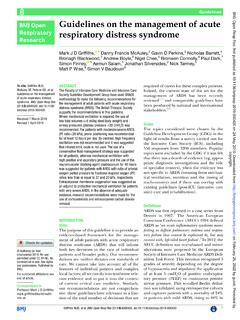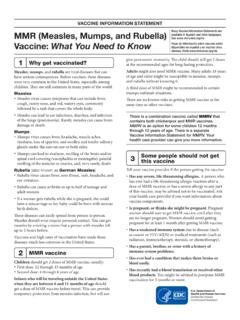Transcription of Guideline British Thoracic Society Guideline for oxygen ...
1 British Thoracic Society Guidelinefor oxygen use in adults in healthcareand emergency settingsBRO Driscoll, L S Howard, J Earis, V Mak, on behalf of the BTS EmergencyOxygen Guideline Development GroupTo cite:O Driscoll BR,Howard LS, Earis J,et Thoracic SocietyGuideline for oxygen use inadults in healthcare andemergency settings .BMJOpen Resp Res2017;4:e000170. Additional material isavailable. To view please visitthe journal ( )The concise version of theBTS Guideline should be readin conjunction with the fullversion: Guideline replaces the2008 British Thoracic Societyguideline for emergencyoxygen 17 November 2017 Department of RespiratoryMedicine, Salford RoyalFoundation NHS Trust,Salford, UKCorrespondence toDr BR O Driscoll; full Guideline for oxygen use in adultsin healthcare and emergency settings, pub-lished in Thorax1provides an update to the2008 BTS Emergency oxygen following is a summary of the recom-mendations and good practice points.
2 Thesections noted to within this summary referto the full Guideline SUMMARYP hilosophy of the Guideline oxygen is a treatment for hypoxaemia,not breathlessness. oxygen has not beenproven to have any consistent effect onthe sensation of breathlessness in non-hypoxaemic patients. The essence of this Guideline can besummarised simply as a requirement foroxygen to be prescribed according to atarget saturation range and for thosewho administer oxygen therapy tomonitor the patient and keep within thetarget saturation range. The Guideline recommends aiming toachieve normal or near-normal oxygensaturation for all acutely ill patients apartfrom those at risk of hypercapnic respira-tory failure or those receiving terminalpalliative Assessing patients For critically ill patients, high concentra-tion oxygen should be administeredimmediately (table 1andfigure 1)andthis should be recorded afterwards inthe patient s health record.
3 Clinicians must bear in mind that sup-plemental oxygen is given to improveoxygenation, but it does not treat theunderlying causes of hypoxaemiawhich must be diagnosed and treatedas a matter of urgency. The oxygen saturation should bechecked by pulse oximetry in allbreathless and acutely ill patients, thefifth vital sign (supplemented by bloodgases when necessary), and theinspired oxygen concentration shouldbe recorded on the observation chartwith the oximetry result. (The othervital signs are pulse rate, blood pres-sure, temperature and respiratory rate). Pulse oximetry must be available in alllocations where emergency oxygen isused.
4 Clinical assessment is recom-mended if the saturation falls by 3% orbelow the target range for the patient. All critically ill patients outside of acritical care area ( intensive careunit (ICU), high dependency unit(HDU), respiratory HDU), should beassessed and monitored using a recog-nised physiological track and triggersystem such as the National EarlyWarning Score (NEWS).2. Target oxygen prescription oxygen should be prescribed toachieve a target saturation of 94 98%for most acutely ill patients or 88 92%or patient-specific target range forthose at risk of hypercapnic respiratoryfailure (tables 1 4). Best practice is to prescribe a targetrange for all hospital patients at thetime of admission so that appropriateoxygen therapy can be started in theevent of unexpected clinical deterior-ation with hypoxaemia and also toensure that the oximetry section ofthe early warning score (EWS) can bescored appropriately.
5 The target saturation should be written(or ringed) on the drug chart orenteredinanelectronicprescribingsystem (guidance onfigure 1). administration oxygen should be administered bystaff who are trained in Driscoll BR, Howard LS, Earis J,et Open Resp Res2017;4:e000170. on March 21, 2022 by guest. Protected Open Resp Res: first published as on 15 May 2017. Downloaded from These staff should use appropriate devices andflow rates in order to achieve the target saturationrange (figure 2). Staff should be trained in the use of a range ofdifferent oxygen delivery devices to ensureoxygen is delivered Monitoring and maintenance of target saturation oxygen saturation and delivery system (includingflow rate) should be recorded on the patient smonitoring chart.
6 oxygen delivery devices andflow rates should beadjusted to keep the oxygen saturation in thetarget range. Prompt clinical assessment isrequired if oxygen therapy needs to be initiatedor increased due to a falling saturation level. oxygen should be prescribed and a signatureshould be entered on the drug chart on eachdrug Weaning and discontinuation of oxygen therapy oxygen should be reduced in stable patients withsatisfactory oxygen saturation. oxygen should be discontinued once the patientcan maintain saturation within or above the targetrange breathing air but the prescription for a targetrange should be left in place in case of futuredeterioration and to guide early warning scores(EWS/NEWS).
7 KEY CHANGES SINCE THE FIRST EDITION OF THISGUIDELINE PUBLISHED IN 2008 MethodologyThe evidence review methodology has changed fromNICE methodology to the BTS NICE accredited guide-line production process which is based on the ScottishIntercollegiate Guideline Network (SIGN) methodologyand adheres to AGREE methodology (see section 1).Evidence levels and grade of recommendationThese are now in SIGN format (see section 1 andtables 6and 7).Evidence baseThe evidence base for the Guideline has been updatedto August 2013 (and extended to mid-2016 for key refer-ences). None of the 2008 recommendations have beenchallenged by new evidence, but many of the existingrecommendations are supported by new have been many observational studies but few ran-domised trials directly relevant to the Guideline remit of the Guideline has been extendedThe new Guideline covers not just emergency oxygenuse but most oxygen use in healthcare settings.
8 It alsocovers short-term oxygen use by healthcare workersTable 1 Critical illnesses requiring high levels of supplemental oxygen (section )The initial oxygen therapy is a reservoir mask at 15 l/min pending the availability of reliable oximetry patients with spontaneous circulation and a reliable oximetry reading, it may quickly become possible to reducethe oxygen dose whilst maintaining a target saturation range of 94 98%.If oximetry is unavailable, continue to use a reservoir mask until definitive treatment is with COPD and other risk factors for hypercapnia who develop critical illness should have the same initialtarget saturations as other critically ill patients pending the results of blood gas results after which these patientsmay need controlled oxygen therapy with target range 88 92% or supported ventilation if there is severe hypoxaemiaand/or hypercapnia with respiratory commentsRecommendationsCardiac arrest or resuscitationRefer to resuscitation guidelines for choice of deliverydevice during active highest possible inspired oxygen concentrationduring CPR
9 Until spontaneous circulation has E1 Shock, sepsis, major trauma, drowning,anaphylaxis, major pulmonary haemorrhage,status epilepticusAlso give specific treatment for the E4 Major head injuryEarly tracheal intubation and ventilation if comatose. Recommendation E5 Carbon monoxide poisoningGive as much oxygen as possible using a bag-valvemask or reservoir mask. Check normal or high oximetry reading should bedisregarded because saturation monitors cannotdifferentiate between carboxyhaemoglobin andoxyhaemoglobin, owing to their similar blood gas PO2will also be normal in these cases(despite the presence of tissue hypoxia).
10 Recommendation E6 COPD, chronic obstructive pulmonary disease; CPR, cardiopulmonary resuscitation; PO2, oxygen tension blood Driscoll BR, Howard LS, Earis J,et Open Resp Res2017;4:e000170. Accesscopyright. on March 21, 2022 by guest. Protected Open Resp Res: first published as on 15 May 2017. Downloaded from Figure 1 oxygen prescription guidance for acutely hypoxaemic patients in hospital. COPD, chronic obstructive pulmonarydisease; ICU, intensive care unit; NIV, non-invasive ventilation; PO2, oxygen tension; PCO2, arterial or arteriolised carbon dioxidetension; SpO2, arterial oxygen saturation measured by pulse Driscoll BR, Howard LS, Earis J,et Open Resp Res2017;4:e000170.

